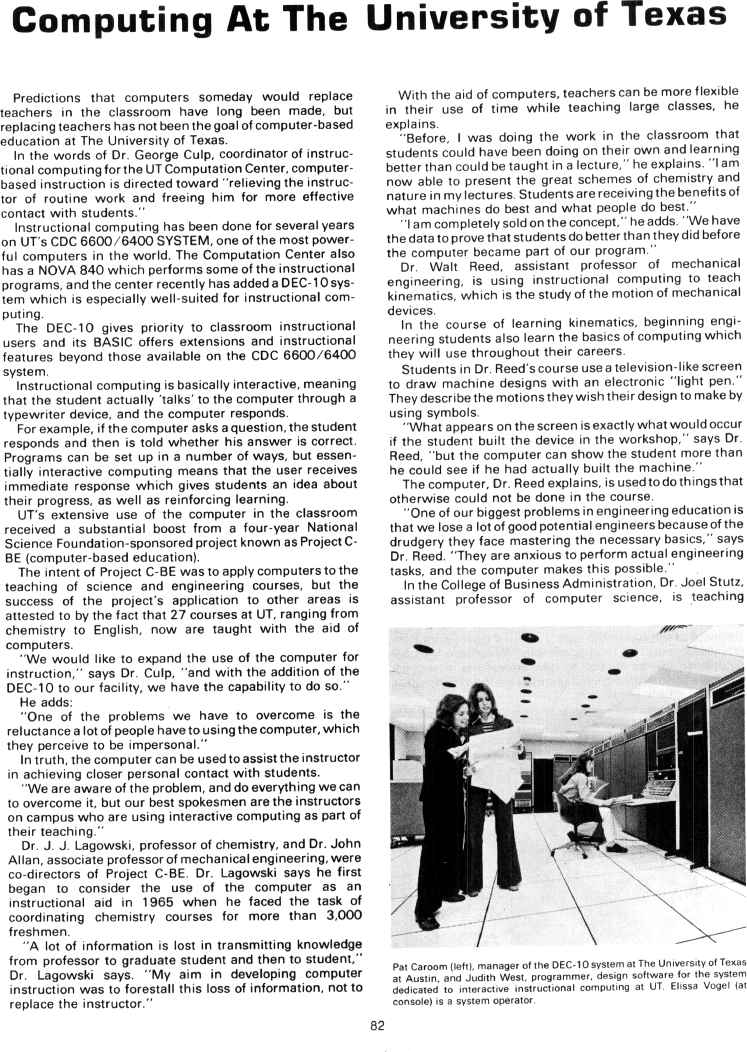The Best of Creative Computing Volume 2 (published 1977)
Computing At The University of Texas (computer-based instruction, DEC-10)

Computing At The University of Texas
Predictions that computers someday would replace teachers in the classroom have
long been made, but replacing teachers has not been the goal of computer-based
education at The University of Texas.
In the words of Dr. George Culp, coordinator of instructional computing for the
UT Computation Center, computer-based instruction is directed toward "relieving
the instructor of routine work and freeing him for more effective contact with
students."
Instructional computing has been done for several years on UT's CDC 6600/6400
SYSTEM, one of the most powerful computers in the world. The Computation Center
also has a NOVA 840 which performs some of the instructional programs, and the
center recently has added a DEC-10 system which is especially well-suited for
instructional computing.
The DEC-10 gives priority to classroom instructional users and its BASIC offers
extensions and instructional features beyond those available on the CDC
6600/6400 system.
Instructional computing is basically interactive, meaning that the student
actually 'talks' to the computer through a typewriter device, and the computer
responds.
For example, if the computer asks a question, the student responds and then is
told whether his answer is correct. Programs can be set up in a number of ways,
but essentially interactive computing means that the user receives immediate
response which gives students an idea about their progress, as well as
reinforcing learning.
UT's extensive use of the computer in the classroom received a substantial boost
from a four-year National Science Foundation-sponsored project known as Project
C-BE (computer-based education).
The intent of Project C-BE was to apply computers to the teaching of science and
engineering courses, but the success of the project's application to other areas
is attested to by the fact that 27 courses at UT, ranging from chemistry to
English, now are taught with the aid of computers.
"We would like to expand the use of the computer for instruction," says Dr.
Culp, "and with the addition of the DEC-10 to our facility, we have the
capability to do so."
He adds:
"One of the problems we have to overcome is the reluctance a lot of people have
to using the computer, which they perceive to be impersonal."
In truth, the computer can be used to assist the instructor in achieving closer
personal contact with students.
"We are aware of the problem, and do everything we can to overcome it, but our
best spokesmen are the instructors on campus who are using interactive computing
as part of their teaching."
Dr. J. J. Lagowski, professor of chemistry, and Dr. John Allan, associate
professor of mechanical engineering, were co-directors of Project C-BE. Dr.
Lagowski says he first began to consider the use of the computer as an
instructional aid in 1965 when he faced the task of coordinating chemistry
courses for more than 3,000 freshmen.
"A lot of information is lost in transmitting knowledge from professor to
graduate student and then to student," Dr. Lagowski says. "My aim in developing
computer instruction was to forestall this loss of information, not to replace
the instructor."
With the aid of computers, teachers can be more flexible in their use of time
while teaching large classes, he explains.
"Before, I was doing the work in the classroom that students could have been
doing on their own and learning better than could be taught in a lecture," he
explains. "I am now able to present the great schemes of chemistry and nature in
my lectures. Students are receiving the benefits of what machines do best and
what people do best."
"I am completely sold on the concept," he adds. "We have the data to prove that
students do better than they did before the computer became part of our
program."
Dr. Walt Reed, assistant professor of mechanical engineering, is using
instructional computing to teach kinematics, which is the study of the motion of
mechanical devices.
In the course of learning kinematics, beginning engineering students also learn
the basics of computing which they will use throughout their careers.
Students in Dr. Reed's course use a television-like screen to draw machine
designs with an electronic "light pen." They describe the motions they wish
their design to make by using symbols.
"What appears on the screen is exactly what would occur if the student built the
device in the workshop," says Dr. Reed, "but the computer can show the student
more than he could see if he had actually built the machine."
The computer, Dr. Reed explains, is used to do things that otherwise could not
be done in the course.
"One of our biggest problems in engineering education is that we lose a lot of
good potential engineers because of the drudgery they face mastering the
necessary basics," says Dr. Reed. "They are anxious to perform actual
engineering tasks, and the computer makes this possible."
In the College of Business Administration, Dr. Joel Stutz, assistant professor
of computer science, is teaching
[image]
Pat Caroom (left), manager of the DEC-10 system at The University of Texas at
Austin, and Judith West, programmer, design software for the system dedicated to
interactive instructional computing at UT. Elissa Vogel (at console) is a system
operator.


